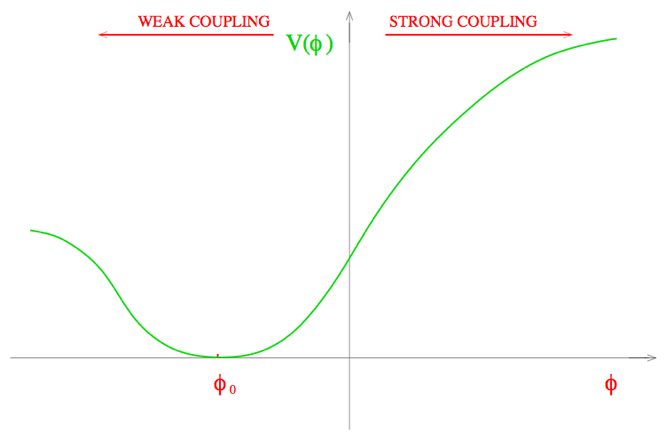The Runaway Dilaton
One of the most amazing successes of String Theory is that of producing the gravitational field as a low-energy excitation. But what type of gravity does the theory describe?
A definite prediction of String Theory is the existence of (at least one) scalar degree of freedom, the dilaton. The vacuum expectation value of the dilaton is related to the couplings in the theory. At tree level the dilaton is massless and strongly coupled with the other fields. This would give rise to unacceptable (unobserved) violations of the Equivalence Principle. Therefore, at tree level, String Theory reproduces a type of gravity very different from what we observe.
The standard solution is:

The Runaway Dilaton:
Gabriele Veneziano has argued in 2001 that the ``strong coupling'' region of String Theory (on the right in the figure above) is made phenomenologically acceptable by string loop corrections. At the level of the effective action the coupling functions of the dilaton “trivialize” to a constant value at infinity:

A potential of non-perturbative origin
1) Stabilizes the dilaton in the weak coupling region
2) Gives the dilaton a mass and shortens its interaction range


Instead of becoming massive as in the above scenario, the dilaton can therefore stay (almost) massless but be running towards infinity, towards its decoupling limit. In this regime, the dilaton can play the role of quintessence. A definite prediction of this scenario is a violation of the Equivalence Principle by composition-dependent effects at the level of the soon-to-come satellite-based experiments MICROSCOPE and STEP.
Bibliography:
M. Gasperini, F. Piazza and G. Veneziano, ``Quintessence as a run-away dilaton”, Phys. Rev. D65 023508 (2002), gr-qc/0108016
T. Damour, F. Piazza and G. Veneziano, ``Runaway dilaton and equivalence principle violations”,
T. Damour, F. Piazza and G. Veneziano, ``Violations of the equivalence principle in a dilaton runaway scenario”, Phys. Rev. D66 046007 (2002) hep-th/0205111
F. Piazza and S. Tzujikawa, ``Dilatonic ghost condensate as dark energy”, JCAP 0407:004 (2004)
L. Amendola, M. Gasperini and F. Piazza, ``Fitting Type Ia supernovae with coupled dark energy”
JCAP 0409:014 (2004) astro-ph/0407573
See Also:
The first two chapters of my PhD thesis for a simple introduction to string gravitational phenomenology, the different types of Equivalence Principle violations, Post-Newtonian parameterization and all that.
T. Damour and A. Polyakov, ``The string dilaton and a least coupling principle” Nuc. Phys. B423 532 (1994) arXiv:hep-th/9401069
G. Veneziano, ``Large-N bounds on, and compositeness limit of, gauge and gravitational interactions”,
JHEP 0206:051 (2001) hep-th/0110129
T. Chiba et. al. ``Time variations of proton-electron mass ratio and fine structure constant with runaway dilaton”, Phys. Rev. D75 043516 (2007) hep-ph/0610027
Invited Talks:
The Search for Variations of Fundamental Couplings and Mass Scales.
Perimeter Institute of Theoretical Physics, Waterloo, July 14 - 18, 2008
Perimeter Institute of Theoretical Physics, Waterloo, Jan 17, 2006
``Dark Energy and alpha variations"
Dark Energy Day, Milano-Bicocca University, November 22, 2002
``Cosmology and gravity of the dilaton at strong coupling"
String/Brane Cosmology, IHES and Universite de Paris-Sud, Orsay (France) September 23-27, 2002